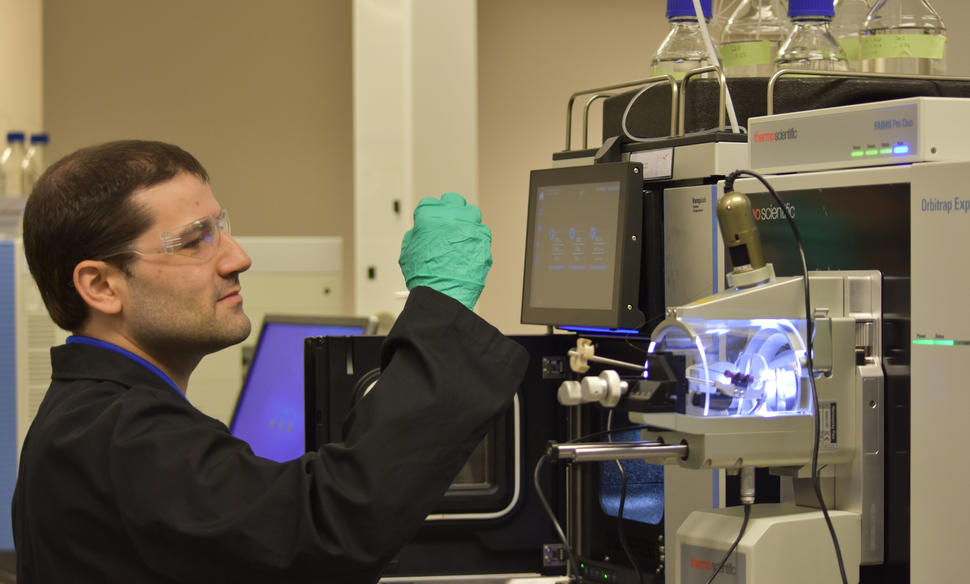RAS Initiative Mass Spectrometry Research
The RAS Initiative Mass Spectrometry Research Team employs cutting-edge protein analysis methods to better understand and target canonical RAS isoforms, RAS-related proteins, and RAS-dependent signaling pathways. Our researchers do this by performing accurate mass determination, sequence characterization, and post-translational modification (PTM) localization on peptides, proteins, and protein complexes.
Progress
We have employed top-down proteomic analysis to analyze intact and modified protein forms, or proteoforms, of HRAS, KRAS4A, KRAS4B, and NRAS within a panel of patient-derived malignant cell lines.
By analyzing intact proteins, rather than the more typical peptides, we have:
- Gained a new perspective on the role of RAS PTMs in human cancer.
- Created new proteomic assays to better characterize the ability of compounds to target and inhibit mutant KRAS4B.
- Optimized new proteomic methods to map PTMs onto specific RAS isoforms (such as KRAS4B), allowing us to identify previously unknown PTMs and better understand their impact on RAS-dependent signaling pathways.
- Developed new proteomic methods to support NCI RAS Initiative reagent validation, structural biology, biophysics, and drug discovery projects.
Projects
In addition to supporting internal and external collaborative projects at the NCI RAS Initiative, RAS Mass Spectrometry maintains a portfolio of ongoing independent proteomic research projects. These include:
- Refining our targeted top-down proteomic methods to identify and characterize context-specific (e.g., RAS mutation status, tissue type) endogenous RAS proteoforms. Learning more about which RAS proteoforms tend to appear in each context, particularly novel proteoforms which only appear in one or more specific contexts, will greatly benefit our efforts to understand their biological significance and identify new therapeutic targets.
- Developing new methods to better detect and map PTMs on RAS isoforms and other proteins within RAS-dependent signaling pathways. While top-down proteomic methods allow us to detect the most abundant PTMs on a given proteoform, lower-abundance PTMs may also play critical roles in directing proteoform stability, localization, and biological activity. Improving our ability to catalog which PTMs are present, precisely determine where they are located, and capture more challenging PTMs like palmitoylation will bring new insight into the roles that each PTM may play in governing RAS activity and signaling.
- Determining the relative abundance of a given proteoform or PTM within a sample. We can also use top-down proteomic methods to calculate the relative abundance of a proteoform or peptide reaction monitoring methods to calculate the abundance of a given PTM within a sample. We employ these methods to answer a range of biological questions by determining relative proteoform (or PTM) stoichiometry, comparing target abundance between contexts, or tracking changes in target abundance over time.
Tools
RAS Mass Spectrometry is a proteomics research laboratory, with the ability to customize sample preparation protocols, liquid chromatography methods, instrument parameters, and data analysis methods to a given target protein or experimental objective. By following this strategy, we are routinely able to achieve successful results with otherwise “impossible” projects.
- Proteomic analyses (top-down, middle-down, bottom-up, native, crosslinking, and combined modalities)
- High-end liquid chromatography systems (Vanquish Neo, UltiMate 3000, Vanquish Binary Flex)
- High-end instrumentation (Orbitrap Exploris 480, Orbitrap Fusion Lumos, and Exactive Plus EMR mass spectrometers)
- Dedicated equipment for in-house part fabrication (laser puller and nitrogen pressure vessel packing system for nanocapillary columns and emitters)
- Optimized workflows for specialized proteomic applications (chromatography resin selection, trap/analytical column specifications, and nano-electrospray ionization sources)
- Tailored protocols for capturing biochemically challenging proteins
- High-throughput data analysis software with manual data validation
The RAS Initiative Mass Spectrometry Research Team
Team lead and contact
Caroline J. DeHart, Ph.D.
caroline.dehart@nih.gov
301-846-6144
Collaborators
- Lissa Anderson, Ph.D., National High Magnetic Field Laboratory (NHMFL). Dr. Anderson is the Director of Biological Applications for the ICR Program at the NHMFL. She is also one of the primary operators of their $20M 21 tesla FT-ICR mass spectrometer and has achieved several world records on that platform. Her work focuses on the application of ultra-high resolving power mass spectrometry to endogenous proteoforms from a range of human disease contexts, including KRAS proteoforms isolated from model and malignant cell lines.
- Luca Fornelli, Ph.D., University of Oklahoma. Professor Fornelli’s laboratory focuses on the development of cutting-edge top-down proteomic methods for improved detection, sequence characterization, and PTM localization of endogenous proteoforms. His work employs prototype mass spectrometers, the latest in available data acquisition technology, and in-development data analysis software to analyze un-enriched proteoforms isolated from cell lines and patient tumors.

